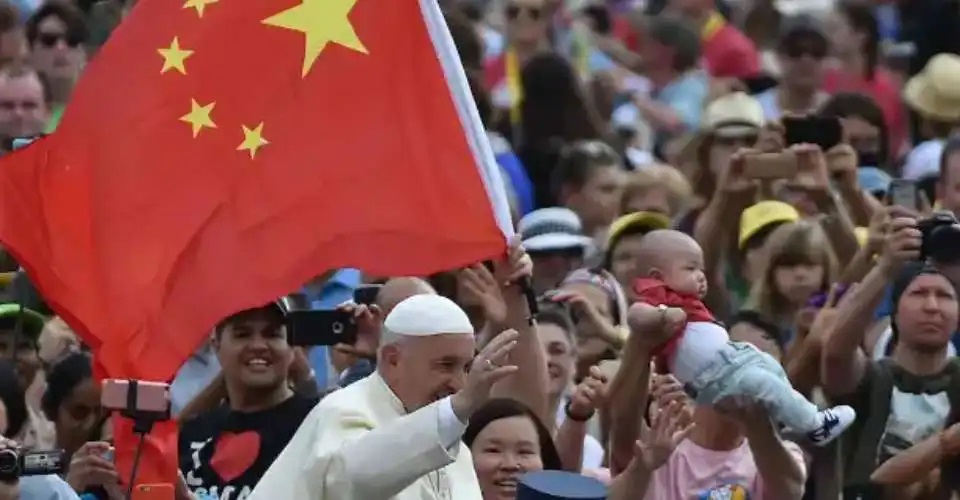The future of Vatican-China relations beyond Pope Francis
The next pope could and should build upon the foundations laid by his predecessors
Apr 28, 2025

By Jonathan Y. Tan
In the arena of religion and politics, international diplomacy, and church-state relations on the global stage, the one question on everyone’s mind as the cardinal electors meet to choose the next pope for the Catholic Church is the future of Vatican-China relations.
On the issue of Vatican-China relations, Pope Francis went one step further than his predecessors.
The pontiff authorised and approved the efforts of Cardinal Pietro Parolin, the Holy See’s Cardinal Secretary of State, to open direct negotiations with Beijing, which culminated in the signing of the landmark provisional accord between the Holy See and China on the joint appointment of bishops in 2018.
Under this provisional 2018 accord, unprecedented in scope and implications, Beijing would seek papal approval on the appointment of Chinese Catholic Bishops and grant the Holy See the right of veto over any episcopal candidate selected by Beijing.
Notwithstanding its provisional nature, the 2018 accord was extended twice for a period of two years each time — in 2020 and 2022. In October 2024, in a vote of confidence by both parties, it was renewed for a period of four years.
Pope Francis has always maintained a deep, abiding interest in China and Catholicism in China. He expressed his desire to visit China ever since he was a newly ordained Jesuit.
In a May 24, 2024, interview with Jesuit Father Pedro Chia who heads the Jesuit Communication Office of the Chinese Province of the Society of Jesus, Pope Francis expressed his heartfelt longing to visit China: “Oh yes, I really want to,” explaining that he would like to “visit the Mother of Sheshan, Mary Help of Christians.”
On his flight from Singapore to Rome on Sept.13, 2024, after completing his whirlwind Southeast Asian tour, his seventh trip to Asia since becoming pope in 2013, Pope Francis responded to reporters’ queries about China.
“China is a promise and a hope for the Church. I would love to visit China,” he said.
Sadly, he was unable to be the first pope ever to visit China before his untimely passing, although he came as close as he could, having visited Mongolia in 2023.
Nonetheless, Pope Francis was not the first pope to take a deep interest in China. As a result of Mao Zedong’s 1952 decision to cut ties with foreign church leaderships and expel all foreign bishops and missionaries, the Holy See was caught in a dilemma and a no-win situation.
The enforced separation and severance of Chinese Catholics from the Vatican by Beijing led to an increasingly aging and dying Chinese episcopate for Chinese Catholics who remained loyal to the Holy See, which would eventually strangle these Catholic communities for lack of new blood, i.e., replacement bishops and clergy who are authorised by Rome.
Both Pope John Paul II and Pope Benedict XVI grasped this stark reality of Chinese Catholics loyal to the Holy See being left bereft of bishops and priests. Hence, they quietly created a framework for recognising, rehabilitating, and regularising illicitly ordained bishops, i.e., Chinese bishops ordained under the auspices of the Chinese Catholic Patriotic Association (CCPA) without prior approval from the Holy See.
On the one hand, these CCPA bishops, although validly ordained and consecrated, are nonetheless “illicit” by canon law, since the CCPA did not seek the prior approval of the Holy See. This means that, notwithstanding the illicit nature of their initial selection and appointment by the CCPA, the Holy See recognizes these CCPA-appointed bishops are properly and validly ordained and consecrated as bishops.
This is because their episcopal ordinations were carried out with the full sacramental norms and proper liturgical ritual by Chinese Catholic bishops who themselves were ordained prior to 1952 or by other pre-1952 Chinese Catholic bishops.
On the other hand, the Holy See was happy to rehabilitate, recognise, and regularise these illicit ordinations, to ensure the long-term survival of the Catholic Church in China with new blood — new Catholic bishops and clergy to serve the thriving Chinese Catholic communities — both CCPA and non-CCPA.
The reality is that the overwhelming majority of CCPA bishops, when given the opportunity, sought the recognition of, and submitted to, papal authority as faithful Catholics who compromised for the greater good of the Chinese Catholic communities they are serving.
Some have even gone further, e.g., Thaddeus Ma Daqin ???, who at his episcopal ordination Mass as Bishop of Shanghai, publicly renounced his membership in the CCPA and was subsequently placed under house arrest at Sheshan Seminary by Beijing.
Clearly, the stark reality of no replacement authorized bishops and clergy for the Catholic Church in China was an overriding existential issue that motivated both Pope John Paul II and Pope Benedict XVI to work for the long-term survival of the Chinese Catholic community in communion with Rome.
Both popes, whose conservative anti-communist credentials are never in doubt, worked quietly behind the scenes to regularise illicitly ordained CCPA Catholic bishops. This ensured the continued survival of the Catholic Church in China with replacement bishops and priests.
More significantly, their decision also pointed to the Holy See’s tacit acceptance that efforts to ensure the long-term survival of the Catholic Church in China and meeting the pastoral needs of Chinese Catholics with new bishops and priests are more important than enforcing purity tests or winning political battles on who could be a Catholic bishop or clergy.
As a result, since the 1980s, with the early steps taken by Pope John Paul II and continued by Pope Benedict XVI, there really is not much difference between the CCPA and non-CCPA Catholic communities in reality.
Theologically, ecclesiologically, liturgically, and pastorally, the CCPA bishops and clergy are fully in line with mainstream Catholicism. They all accept unequivocally the decrees of Vatican II, the post-Vatican II liturgical books, and living the full Catholic sacramental life together with the worldwide Catholic communion, praying for the pope in the Eucharistic Prayer at Masses, as well as maintaining the male priesthood and mandatory clerical celibacy.
The CCPA attempted, for a short time in the early years of its establishment, to exert intense pressure on CCPA clergy to get married. However, it backed down in the face of the overwhelming opposition by a majority of Chinese Catholic bishops and clergy who, notwithstanding their acceptance of its authority and supervision, held firm in their insistence on maintaining mandatory clerical celibacy in communion with the worldwide Catholic discipline on this issue.
How has the 2018 joint accord worked in practice? Away from the limelight, both the Holy See and Beijing have quietly compromised behind the scenes, albeit reluctantly, on each other’s choices for episcopal appointments.
For example, in January 2024, the Holy See reluctantly accepted three new bishops selected by Beijing for the dioceses of Zhengzhou (Taddeo Wang Yuesheng ), Minbei (Peter Wu Yishun), and Weifang (Anthony Sun Wenjun). In turn, in August 2024, after delaying for five years and detaining him in house arrest for defying the CCPA, Beijing reluctantly approved the Holy See’s 2019 appointment of Melchior Shi Hongzhen as Bishop of Tianjin despite his steadfast refusal to join the CCPA and accept the CCPA’s oversight on his appointment.
Leading up to the successful renewal of the 2018 accord in October 2024, these two examples in 2024 suggest that both the Holy See and Beijing are keen and optimistic about rapprochement and building a good bilateral working relationship.
Without a doubt, it appears that both the Holy See under Pope Francis and Beijing under Xi Jinping have been keen for this agreement to succeed in the long term.
For the Holy See, what is at stake is the future of the Catholic Church in China. As far as the Holy See is concerned, there is only one Catholic Church in China in terms of sacraments, theology, liturgy, and morality.
The CCPA Catholic bishops and clergy are fully Catholic in terms of sacraments, theology, liturgy, morality, and ethical living. The stumbling block has always been political and diplomatic — the power and authority to select and appoint new bishops, who in turn are empowered to ordain new clergy for the Catholic Church in China.
At the 2025 papal conclave, for the first time ever, one of the eligible cardinal electors in the 2025 papal conclave is from China (Hong Kong), giving the Chinese Catholics a voice in the 2025 papal conclave and debates on Vatican-China relations and the future of Chinese Catholics. Before he was appointed by Pope Francis to be Bishop of Hong Kong in 2021 and elevated to Cardinal in the 2023 Consistory, Cardinal Stephen Chow Sau-yan, a member of the Society of Jesus, served as Provincial of its China Province from 2018 until 2021.
Finally, a more profound reason why this mattered to Pope Francis is the reality that, notwithstanding rigid communist control of the contemporary Chinese society, Chinese churches — both Protestant and Catholic — are packed even on an ordinary Sunday.
In the interview with Father Pedro Chia, SJ, Pope Francis spoke admiringly of the Chinese people generally and Chinese Catholics in particular, marvelling at their faith, “indeed a faithful people who have gone through so much and remained faithful.” He described them as “masters of patience, masters of waiting” with “the virus of hope,” which “is a very beautiful thing.”
According to the pontiff, they “must not waste their heritage,” but on the contrary, “they must patiently carry forward their legacy.”
The possibility of robust and thriving Vatican-China relations, first initiated by Pope John Paul II and Pope Benedict XVI, and developed by Pope Francis, is something the next pope could and should build upon, taking the next steps to strengthen and grow Vatican-China relations on the foundations laid by his predecessors.
This is because a successful Catholic Church in China, which remains loyal to the Holy See, represents the best exemplar and model of an enthusiastic and flourishing Catholic minority that is growing and thriving despite the challenges of an officially secular society like China.
More importantly, this could also serve as an example to Europe and North America, where Christianity generally, and the Catholic Church in particular, struggles to grow in the face of secularism and its ensuing skepticism of organised religion of all kinds, Christianity included. While there will be roadblocks and obstacles, nothing is insurmountable with patience and perseverance, dialogue, and careful negotiations.--ucanews.com







Total Comments:0